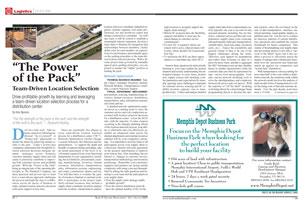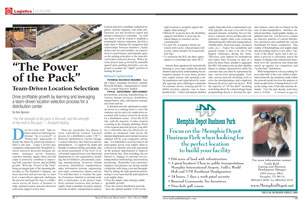
 “For the strength of the pack is the wolf, and the strength of the wolf is the pack.” – Rudyard Kipling
“For the strength of the pack is the wolf, and the strength of the wolf is the pack.” – Rudyard Kipling
Don’t be a lone wolf. Take extreme caution in following traditional “do-it-yourself” or “broker-led” approaches to dictate the future by achieving similar results to the past. Today’s world-class companies understand that thoughtful location selection decisions integrate dynamic strategies across business, customer demand, supply chain and real estate to positively contribute to improving both customer service and profitable growth. With the “Power of the Pack” being an integral part of the operating philosophy at The Staubach Company, use these practical and proven tips to learn how a team-driven approach challenges the process and leads the way to collaboration across all facets of business to make optimal location selection decisions with more support in less time.
There are essentially five-phases to every team-driven location selection process for a distribution center (“DC”)– Network Optimization, Facility Design, Location Selection, Site Selection and Implementation. To support the depth and breadth of analysis during each phase, take an initial assessment of the level of involvement required from cross-functional departments in your organization, including, but not limited to, procurement, sourcing, manufacturing, inventory, human resources, distribution, transportation, sales, information systems, engineering, real estate, construction, finance and tax. You will then have to evaluate the quality of resources (internal or external) available to participate on the project team. Such external resources may include a supply chain consultant, inventory analyst, network modeler, transportation analyst, location selection consultant, industrial engineer, systems engineer, real estate professional, tax and incentives expert and design-construction consultant. As with any team, it will be critical to establish a meaningful mission statement, develop a team chart to illustrate the integration and relationships between members, clearly define roles for each member, set expectations for performance and mutually agree on the guiding principles to the team-driven location selection process. With a diverse project team governed by mutually agreed upon guiding principles, you are poised to assume the “alpha” position in leading the pack.
Network Optimization
Potential Resources Required: Supply Chain Consultant, Inventory Analyst, Network Modeler, Transportation Consultant, Location Selection Analyst
Typical Department Involvement: procurement, sourcing, manufacturing, inventory, human resources, distribution, transportation, sales, information systems, real estate and tax.
A detailed network optimization analysis serves as a starting point to solve the customer service and cost complexities associated with location selection decisions for a distribution center. Given the 80/20 rule, with the majority of value creation occurring in the strategic planning efforts of the location selection process, your ability to efficiently and cost-effectively assemble an integrated team across the internal departments and external resources outlined will be your competitive advantage. It is important to actively listen to all participants across your supply chain to collectively identify and seek agreement on the greatest opportunities to improve your bottom line, often including, but not limited to, changes in customer service, transportation methodology and inventory positioning. Remember your customers, suppliers and partners are facing similar complexity with rising costs and demands. Start by asking the right questions and listening to your team and the participants in your supply chain.
-
Does the supply chain strategy enable profitable growth?
-
Does the current distribution network have the optimal number of DCs in the right locations to properly support the supply chain strategy?
-
Which DC locations have the flexibility, capacity and ability to meet any demand-change in customer service commitments?
-
If a new DC is required, which customers will it serve, what products will it carry, where should it be located and how big?
-
To maximize the ROI, are there opportunities to consolidate any other DCs?
Answer these questions by meticulously listening to your team explain the present situation and acutely understanding the anticipated changes in cycle times, product mix, supply sources and operating costs. Set parameters and expectations by mutually agreeing upon challenges-constraints for customer service, sourcing and DC viability (location, capacity, own vs. lease, productivity). Collect and analyze detailed supply chain data from a representative period, typically one year to account for any seasonal demand, including, but not limited to, customer service profiles and comprehensive supply chain costs (sourcing, inbound/transfer/outbound transportation, variable-labor, fixed-real estate, inventory carry, etc.). Expect the availability and general format of data to be one of the biggest challenges during the study. Therefore, seek support for assumptions and rather than focusing on data on a piece-by-piece basis, attempt to aggregate the SKU information into product families based on similar characteristics while the customer data can often be represented by type - service level and geography. Evaluate various network modeling tools to solve the interdependence and complexity between all service and cost factors. With the majority of “off the shelf” modeling tools being driven by a mixed integer linear programming theory to develop the optimal solution, select the tool based on the ease of data manipulation - interface, statistical reporting, visual-graphic display capabilities and cost. Use the tool to conduct an objective analysis of current distribution operations and establish the current benchmark for future comparison. This routine of benchmarking your supply chain and developing metrics is not only a “survival of the fittest” tactic, but it also enables a process to efficiently assess the impact of changes and continuously determine how the operations and financials match up against top competitors and “world-class” distributors.
With transportation costs accounting for more than half of the costs within a distribution network, the sensitivity study within the network model involves the analysis of multi-modal forms of transportation to offset the rising costs of fuel and customer demands. Over the past decade, ports have seen a ten-fold increase in imports from the Asia-Pacific to meet unparalleled consumer demands - expectations for product quality, availability and responsiveness at an acceptable price point. Therefore, consider modeling a shift in supply points from current manufacturing locations to numerous domestic ports (4X more container traffic on the west coast than the east coast). These trends require continuous optimization of service and costs within the distribution network.
Proactively utilize this optimization process to interview your top customers and lead suppliers for feedback regarding the opportunity to adjust service and cost components within the distribution network. With a data-rich modeling tool, use the sensitivity studies and customer-supplier feedback to leverage your cross-functional team in developing multiple “what if” scenarios to analyze the optimal solution. Back to the 80/20 rule, your team’s interpretation of the model results and their quantitative-qualitative network experiences will be the critical element defining the optimal distribution network. Seek agreement first on the scenarios to eliminate then mutually agree upon a primary distribution network configuration. With the right dots on the map, design-size the distribution center(s) and outline a location selection strategy to capture the maximum cost reduction or avoidance while being capable of handling the incremental customer demands and flexible enough to react to market changes.
Distribution Center Design
Potential Resources Required: Inventory Analyst, Industrial Engineer(s), Systems Engineer
Typical Department Involvement: inventory, sales, human resources, engineering, distribution and information systems.
Recognize that the location selection process presents a unique opportunity to properly analyze and establish new design criteria for a distribution center. Aggressively take the lead to improve facility layout and productivity by analyzing customer order profiles and inventory. Work with your sales and inventory team members to understand the data and relationship between shipping volume and customer order complexity over a one-year period. This will enable you to segregate and group your inventory from a SKU level to a product family based on storage-handling or velocity characteristics (ABC analysis). In order to ensure the future viability of the distribution center, develop and project such data to a model year, typically five years in the future.
To properly size your distribution center, leverage your industrial engineering and design consulting resources to classify the above information into fulfillment and storage areas within the distribution center. The fulfillment process (typically two-thirds of the labor for a distribution center) will be driven by the percentage and velocity of orders in terms of pallets, cases or eaches as pulled from and slotted within a pick area. On the other hand, the storage area (typically two-thirds of the space for a distribution center) will be determined by the ability to properly utilize or maximize cubic space through various types of racking based on size and volume of SKUs. Based on the throughput characteristics, integrate the appropriate travel aisles and staging-loading-dock areas to the fulfillment and storage areas to calculate the optimal size, functionality and productivity of your distribution center. Constantly challenge yourself to maximize the ROI in labor, material-handling equipment and information systems by quantifying the benefit of each cost in terms of time, money and effort. Perform value engineering to ensure economic, safety, and flexibility issues are constantly being met. Working from the inside out will enable you to scope the DC in terms of purpose, size and labor thus maximizing your opportunity to capture the greatest fixed (real estate) and variable (labor) cost savings prior to embarking on the location selection strategy.
Location Selection
Potential Resources Required: Location Selection Analyst, Transportation Consultant, Labor Analyst, Real Estate Professional, Tax & Incentives Expert
Typical Department Involvement: distribution, transportation, human resources, real estate and tax.
With geographical direction for the next DC location from the network optimization analysis, conduct internal working meetings with your project team to determine achievable goals-objectives (“project drivers”) and a practical implementation strategy. Develop a realistic timetable and a communications program for all team members to set the foundation for a successful project and a vehicle for shareholder and stakeholder support of critical project drivers. Stretch the geographic parameters from the network study, typically a 100- to 300-mile radius from the optimal point, to establish a Target Geographical Area (“TGA”) for consideration. Consider an alternative to the traditional site selection methodology utilizing Metropolitan Statistical Areas (“MSAs”), counties or cities by developing specific Custom Geographic Areas (“CGAs”), typically driven by a 20-mile radius from various points of influence within the TGA. Determine three to five criteria essential to the success of the project, called threshold criteria that each CGA must meet. Conduct a “high-level screen” to obtain consensus and eliminate those CGAs that do not meet the threshold criteria. For maximum impact, the high-level screen should produce a minimum of six CGAs across three states for consideration.
Lead a team approach in developing an objective decision model, which accounts for both quantitative and qualitative advantages and tradeoffs. Research and analyze specific criteria related to labor force, distribution climate, and operating costs/issues. Look beyond the “off-the-shelf” labor information to quickly focus on relevant correlations — such as the relationship between a diverse workforce and unionization, high school graduate population and warehouse worker density, or the relationship between a handicapped workforce and public transportation. Determine the specific labor criteria by benchmarking the positive qualities found in the most efficient and productive DC in your current network, if applicable. Utilize your location selection and labor analysis to take a deep dive into detailed information on unionization by CGA, labor competition by SIC/NAICS code, employee turnover by industry-position, alternative labor sources (retired, handicapped, etc.) and language capabilities. Understand the make-up of a diverse, productive and cost-effective workforce within the TGA. Regarding the distribution-climate criteria, account for changes in transportation infrastructure, competitor facilities, and relevant community acceptance attributes. Challenge your transportation consultant on the capacity of local transportation carriers (ocean, rail, TL, LTL, parcel, air), proximity to transportation terminals and drayage rates. The operating cost and issues will be driven by your DC project profile across the following major cost categories: transportation, labor, real estate, utilities and tax structures/incentives. Think about looking at utility reliability / redundancy from dual power, electrical charge schedule by demand and consumption, hazardous materials / environmental regulations and projected business and economic incentives impact.
Tailor all of these data points to your needs in a mathematical decision model that weights, ranks, and plots the data in a report format that is easy to read. Create a decision matrix of advantages and tradeoffs to provide additional life to the results as well as help build an educated decision-making consensus on relevant information. Ultimately, arrive at a short-list of two or three CGAs in two states to commence the site selection process.
Site Selection
Potential Resources Required: Labor Analyst, Real Estate Professional, Design and Construction Consultant, Tax & Incentives Expert
Typical Department Involvement: procurement, human resources, distribution, transportation, real estate, engineering, construction, legal and tax.
Prevent fatal and costly mistakes by taking CGA tours to gain firsthand experience of the primary economic and community criteria. More than checking your homework from the location selection process, roll up your sleeves and develop your own gut feel on the right site and location for your distribution center.
Labor Evaluation – Validation
Meet with community leaders within each CGA to understand the future growth industries as well as population and demographic trends (growth or decline). Ask the tough questions and drive the market to understand the competitive workforce environment and labor union presence and penetration history. Use a labor analyst to interpret, qualify and rate the competition and union impact on the direct correlation between labor supply and costs. Examine wage structures within the CGA against the job classification and cost benchmarks generated in the location selection model. Set up interviews with other DC operations to verify all labor data on hiring, turnover, wage scales and incentives as well as an overall comfort level for the distribution climate. For a more targeted approach, consider a “psycho-graphic” analysis to identify the economic traits and geo-demographic segments of individuals consistent with your benchmark DC. Take all of these steps to educate your team on the labor risks and costs associated with each CGA. With labor being the largest cost category within the four walls of the DC, eliminate a CGA(s) based on your findings.
Real Estate Due Diligence
Define all potential real estate scenarios to understand each CGAs’ issues, weaknesses, and strengths, as well as windows of opportunity created by current real estate market conditions and expected changes within a CGA. Develop a comprehensive real estate spreadsheet and map of each CGA to evaluate the availability, cost, and accessibility of potential real estate alternatives. Push your real estate professional and construction consultant to capture meaningful real estate information, including, but not limited to, size (square feet or acres), zoning, surrounding uses, utility-transportation infrastructure, ingress/egress, cost (lease or purchase), topography and comment on any challenges or opportunities.
Tax Structures / Business & Economic Incentives
Prepare a business profile to help you solicit tax abatements and incentives from various economic development councils. Recommend a low-high approach to cover worst and best case scenarios. Review recent tax abatement and incentive allocations of comparable DC projects prior to meeting with each location’s economic development groups to determine the overall incentive value for your project. Work in conjunction with your tax structures / business & economic incentives expert to develop a negotiation strategy and conduct a comprehensive proposal process to drive the appropriate type and value of an incentives package, including but not limited to corporate income tax credits, ad valorem tax abatements (real and personal property), sales/use tax exemptions, infrastructure grants, low interest financing, relocation assistance and employee retention/training programs. Based on the real estate due diligence, some of the sites may be located in enterprise or foreign trade zones which will enhance the value and opportunities of the package. Don’t be afraid to challenge the process and ask fora legislature change to effectively use incentives as a differentiator. With approximately 85% of all negotiated incentives never being realized or utilized, structure your team (internal and external) to make sure your documentation and implementation captures the value.
At the conclusion of the CGA tour, you will be in a position to make a confident recommendation of the primary state / CGA / site and back-up, supported by well-constructed, objective and subjective information. Now make it happen through seamless, creative implementation to convert recommendations into results.
Implementation
Potential Resources Required: Real Estate Professional, Tax & Incentives Expert, Industrial Engineer, Systems Engineer, Design and Construction Consultant, Financial Structuring Expert
Typical Department Involvement: procurement, distribution, transportation, real estate, construction, finance and tax.
Maintain competitive leverage in the real estate and tax process by maintaining primary and back-up alternatives through a formal request for proposal process. From a real estate perspective, set the stage for flexibility in the written request for proposal documentation with various options for contraction, termination, renewal, expansion, purchase, etc. In working with the appropriate government officials at a state, county, city and local level, utilize all of the information outlined and captured above to effectively finalize any tax abatement and incentive negotiations. Use your external resources to assist you in maintaining third party negotiating position to work every angle of both deals until the ink isdry. Always execute the tax abatement and incentive agreement prior to the real estate contract. Prevent any profit erosion by controlling the balance of the implementation process with your integrated team actively managing the real estate acquisition / disposition, facility design and construction, material handling and information systems procurement, real and personal property financing, integration / installation and third party logistics outsourcing (if applicable). Evaluate running the distribution operation through a third-party logistics service provider rather than yourself. Their experiences and advice may be worth more than you think. Keep leading by challenging your team to improve the team-driven location selection process.
True project success will be defined by a team-driven location selection process which enables each DC to contribute to long-term profitable growth.

